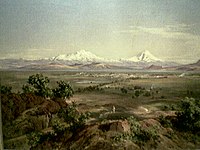
Photo from wikipedia
Abstract This study was aimed at investigating the hydrogeochemical and isotopic characteristics of low-temperature hydrothermal springs in six study sites located in the eastern portion of the Trans-Mexican Volcanic Belt,… Click to show full abstract
Abstract This study was aimed at investigating the hydrogeochemical and isotopic characteristics of low-temperature hydrothermal springs in six study sites located in the eastern portion of the Trans-Mexican Volcanic Belt, in order to evaluate the source of the thermal water, rock-water interactions, and reservoir temperature. In addition, based on this, possible similarities and differences among these thermal springs were explored. Samples of thermal waters (12 samples) and non-thermal waters (6 samples) were collected during dry and rainy seasons. Stable isotopes (18O, 2H) as well as major, minor, and trace ions were analyzed for, and saturation indices and reservoir temperatures were estimated. Thermal water temperatures ranged from 33 to 55°C and the pH was slightly acid (and slightly basic in only one case). The electrical conductivity ranged widely, from 0.2 to 27 mS/cm, although most samples had > 8 mS/cm. Using a Piper diagram, three hydrochemical facies were identified: Na-Cl, Na-Ca-SO4-HCO3, and Na-HCO3. The notable minor and trace elements and ions were B, Li, As, and F− . δ18O and δ2H values plot very close to the meteoric water line, although samples from three of the study sites showed a possible isotope exchange between water and minerals at high temperatures. By estimating reservoir temperatures using solute geothermometers and saturation indices, it was possible to determine similarity among the values obtained (90 to 190°C). These data indicate that the hydrochemistry of the thermal waters reflects a water source that is related to geothermal brines in some cases, and with the mixing of a thermal fluid and a recently infiltrated water in other cases, as well as water-rock interactions (mostly with silicates) and carbonate precipitation.
Journal Title: Geothermics
Year Published: 2021
Link to full text (if available)
Share on Social Media: Sign Up to like & get
recommendations!